When in lockdown Italy? Here are my 10 favorite recipes
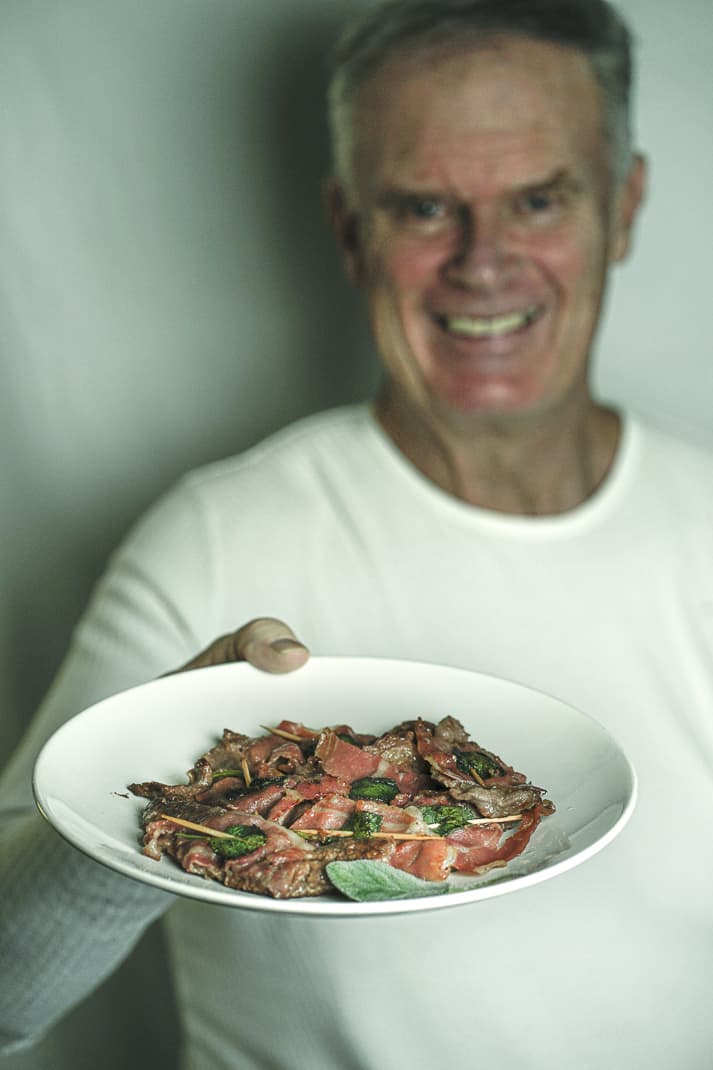
Hello again from post-lockdown Italy where Monday I finished my second quasi house arrest in the land that Covid first engulfed. I was in lockdown so long I started a 10-part Netflix series on blood clots. I walked past pubs, long closed, and got weepy at the mere sight of a Peroni sign. My mask has formed a semi-visible indentation on my face.
People ask me what’s the biggest problem with being in lockdown in Italy. It isn’t the isolation. It isn’t the absence of socializing over a good bottle of wine with friends. It isn’t wearing a mask everywhere.
It’s the restaurants.
With the exception of a couple days, since Christmas holidays all restaurants in Italy were closed except for takeaway or delivery. Also, bars were closed and you could not travel across regional borders without an “essential” purpose. You could host no more than two people. Dining in restaurants became a more distant memory with every passing day. Yes, I could order delivery. I ordered the occasional pizza from C’Era Una Volta, my little pizzeria around the corner.
But it’s not the same. I want to relax in a cozy trattoria with good friends and the best food and wine and WAIT SERVICE in the world. Eating out in Italy isn’t fuel. It’s art. I live in Rome. Living in Rome with all the restaurants closed is like an alcoholic living in Dublin during Prohibition. So what do I do?
I cook.
A lot. I’m not a good cook. However, I am a good cook in Italy. The ingredients available in the open-air public markets, alimentaries (meat and cheese shops), fruit stands and even supermarkets are far superior to everything in the U.S. When I returned to Denver after my first stint in Rome from 2001-03, I stopped cooking Italian dishes after one too many meals had all the flavor of dry gruel. The tomatoes had no flavor. The parmesan had no bite. The prosciutto and sausage had too much fat.
Even in lockdown in Rome, I eat pretty well. However, my rotation of recipes is painfully small. I have a list of standbys, mostly traditional Roman cuisine, I have collected over the years. I have taken some from my girlfriend, Marina, a third-generation Roman who cooks as well as her mother, who, like all Italian mothers, should open her own restaurant.
One constant wine bar discussion among friends here is what region in Italy has the best food. For years I went back and forth between Sicily (incredible fish and that cannoli!) and Emilia-Romagna (best antipasti in Italy) but after seven years in Rome I am going with Lazio.
It’s traditionally simple food. Why? For years, particularly after World War II, Rome was poor. Poverty was everywhere. Romans needed simple, cheap ingredients. They even used the cheapest, spare animal parts such as pajata (intestines from an unweaned calf), trippa (stomach lining of farm animals) and coda (oxtail) from Mattatoio, the long-closed slaughterhouse near my old apartment in Testaccio. Those foods are still sold today.
I’ve tried them all and pajata has the general texture and taste of sliced snakes. I stick with traditional Roman recipes, rich in tomato sauce, pancetta (Italian bacon) and my favorite Italian meat, guanciale (pig’s cheek).
So if any of you are itching for Italian food and your local restaurants are under lock and key, here are my 10 favorite Italian recipes (in no particular order) I cook on a monthly basis. The recipes are for one person. Just double it, unless you live alone like me. It’s a short list. I know. I need a cooking class.
But those are cancelled here, too.
(Please note: All dishes should be served with extra virgin olive oil from Italy. Don’t get your supermarket’s cheap generic brand. Also, add half a handful of bulk salt when you put the pasta in the boiling water and cook it al dente or two minutes less than the directions say. Taste before serving, of course. I leave the amount of pasta up to you.)
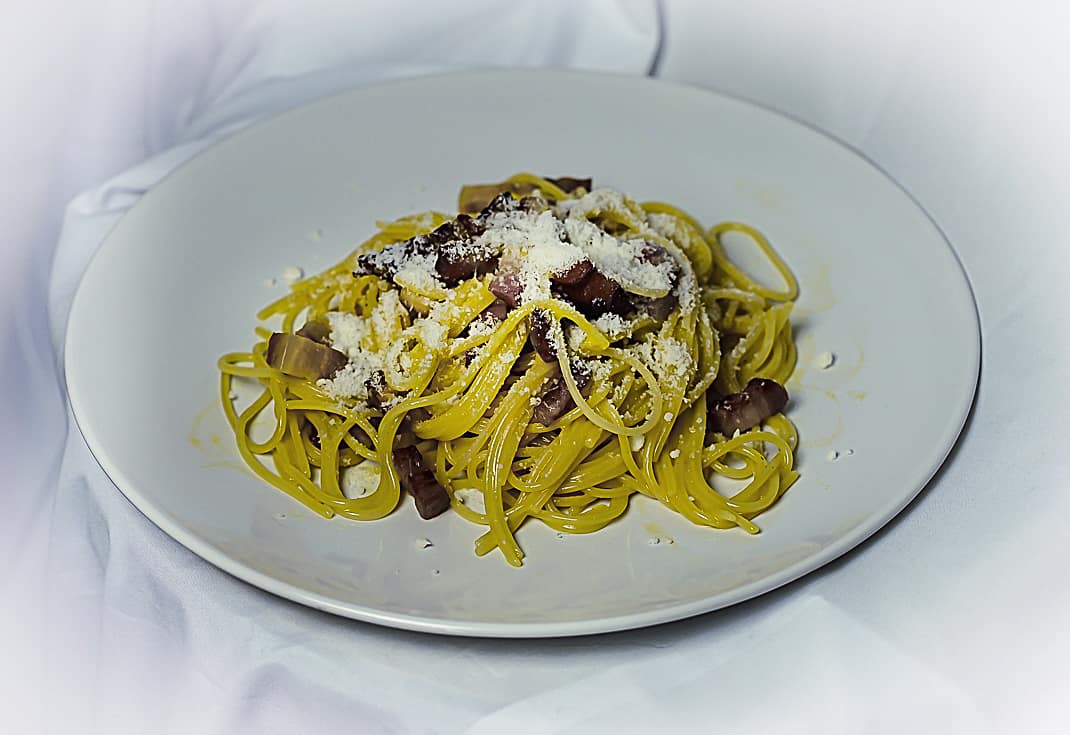
Pasta carbonara
This may be the most classic of all Roman dishes. It dates back to 1944 when Romans found a way to use the eggs and bacon given to them by U.S. troops during World War II. In 1950, the Italian newspaper La Stampa named it carbonara after it became a popular dish with American soldiers when they liberated Rome. Carbonara roughly translates to “manner of coal miners.” The black pepper sprinkled in the pasta looks like coal dust. Sort of. Get it? Try it after a couple glasses of Chianti. It’ll make sense.
This dish is heavy. The sauce is thick (or it should be) and the pancetta adds the punch. Every restaurant and trattoria in Lazio serves this dish. It’s easy to make but also easy to screw up. I’ve butchered a few batches.
Ingredients
Spaghettini No. 3 by Barilla (a thinner form of spaghetti)
Two eggs
Guanciale (pig’s cheek) chopped
½ cup grated pecorino romano (sheep cheese)
Pepper
Directions
Put egg yolks in bowl and discard egg whites. Mix in pecorino romano and add two or three dashes of pepper. Place pasta in a large pot of boiling water and cook guanciale for 7-8 minutes until it darkens and becomes slightly crisp. Drain pasta and conserve one cup of excess water in case the sauce is too dry. Put guanciale in pot with pasta then mix in egg and pecorino mixture. If too thick, add water. Pour onto dish and top with generous amount of pecorino.
Wine pairing: Chianti Classico from Tuscany.
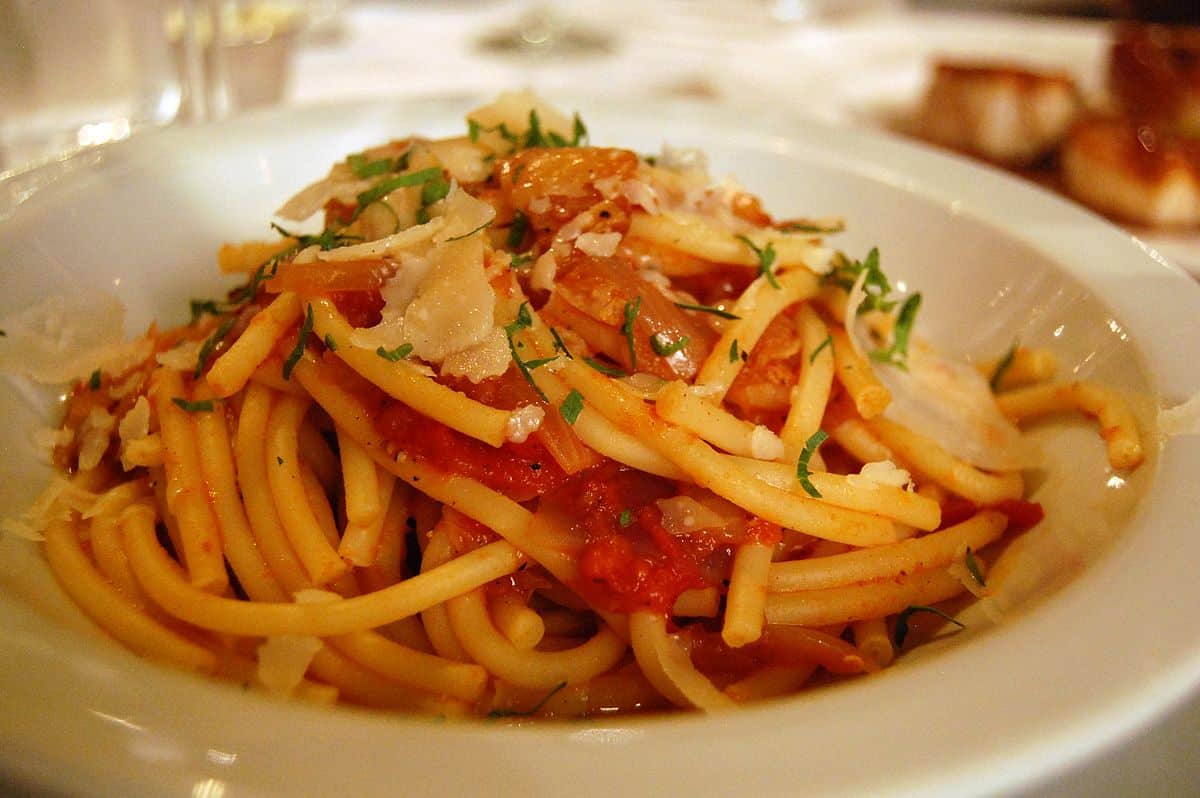
Bucatini all’amatriciana
Back in the 1600s, migrating shepherds would gather local products they could carry and put them in a pot. This simple dish of guanciale (cured pig’s cheek) and pecorino was handy, easy and filling. When tomatoes were introduced to Italy in the 1700s, a red sauce was added in the town of Amatrice, a Lazio town about 90 miles north of Rome from where it became the dish we know today.
In 1816 Francesco Leonardi, a renowned Roman cook and food author, served it to the Court of Pope Pius VII. So impressed, the pope had it later served at the Quirinale in honor of Emperor Francis I of Austria.
This is my signature dish, the one even I find hard to screw up.
Ingredients
Bucatini pasta (a long, round pasta)
2 ounces guanciale (can substitute pancetta) chopped
2 tomatoes, peeled seeded and chopped
Dash of red pepper flakes
Salt
Pepper
¼ cup grated pecorino romano
Extra virgin olive oil
Directions
In a large pan cook the guanciale in the olive oil until it becomes crispy, about 6-8 minutes. Set aside. Put the tomatoes in the pan and add the pepper flakes then season with salt and pepper. Cook for 10 minutes and make sure the sauce doesn’t thicken. Add water if necessary. Return guanciale and reheat. While the sauce simmers, cook the bucatini, drain the water then add the sauce. Top with pecorino and serve. (Note: If you’re like me and have developed an unhealthy addiction to pecorino similar to crack cocaine, mix in a big dollop of the grated gold while you mix in the sauce. Then top it with more before eating.)
Wine pairing
Montepulciano d’Abruzzo.

Pasta puttanesca
In Italy, every dish has a backstory and this is one of my favorites. Puttanesca is known as the “Prostitute’s pasta sauce.” The story goes that this sauce began during World War II in Naples where the job market was so bleak many women turned to prostitution. This dish made up of spaghetti, olives, capers and tomatoes is simple and could be made in 15-20 minutes. The prostitutes could eat it between customers. Thus, puttanesca (puttana is Italian for “whore”) was born.
More prudent historians cite a restaurant on the island of Ischia, in the Bay of Naples where sometime in the 1950s some customers near closing asked the owner to “puttana qualsiasi” (prostitute anything) and the owner threw together the remaining ingredients he had sitting around.
Myself? I prefer the first story. Plus, it’s true: I can make it between soccer matches on TV. (Note: Don’t tell this story on a first date. This sauce is a bitch to get out of a shirt.)
Ingredients
Spaghetti
Handful pitted black olives and halved
1 tablespoon capers
3-4 fresh tomatoes, crushed
1 anchovy finely chopped
1 clove garlic
Salt
Pepper
Olive oil
Parsley
Directions
Peel the tomatoes and discard the seeds and skin. Crush the pulp. Brown the garlic and in the same large pan saute the tomatoes, anchovy, olives and capers. Flavor with salt and pepper and simmer for 15 minutes. Cook and drain pasta then add to sauce. Top with sprinkles of parsley.
Wine pairing
Nero d’Avola from Sicily.

Cacio e pepe
This simple but hearty dish dates back to the Roman Empire when shepherds could easily carry the dry pasta, pecorino and pepper during their rounds. The ingredients don’t spoil. Plus, their sheep gave them a ready supply of pecorino. So popular is this dish in Rome, there’s even a restaurant near the Vatican in the Prati neighborhood simply called Cacio e Pepe.
Ingredients
Spaghetti (or bucatini)
1/4 cup pecorino romano
Pepper
Half cup water
Directions
While cooking the pasta, in a large bowl grate the pecorino. (I recommend not getting the pre-grated version. It doesn’t melt quite as well as fresh pecorino you grate yourself. Plus, with pasta dishes, you could use the exercise.) Liberally add pepper and mix with water until you have a nice smooth sauce. Add more water if it’s too thick. Add the cooked pasta and mix vigorously to cover each strand. Serve in a bowl and sprinkle with more pecorino.
Wine pairing
Cesanese from Lazio.
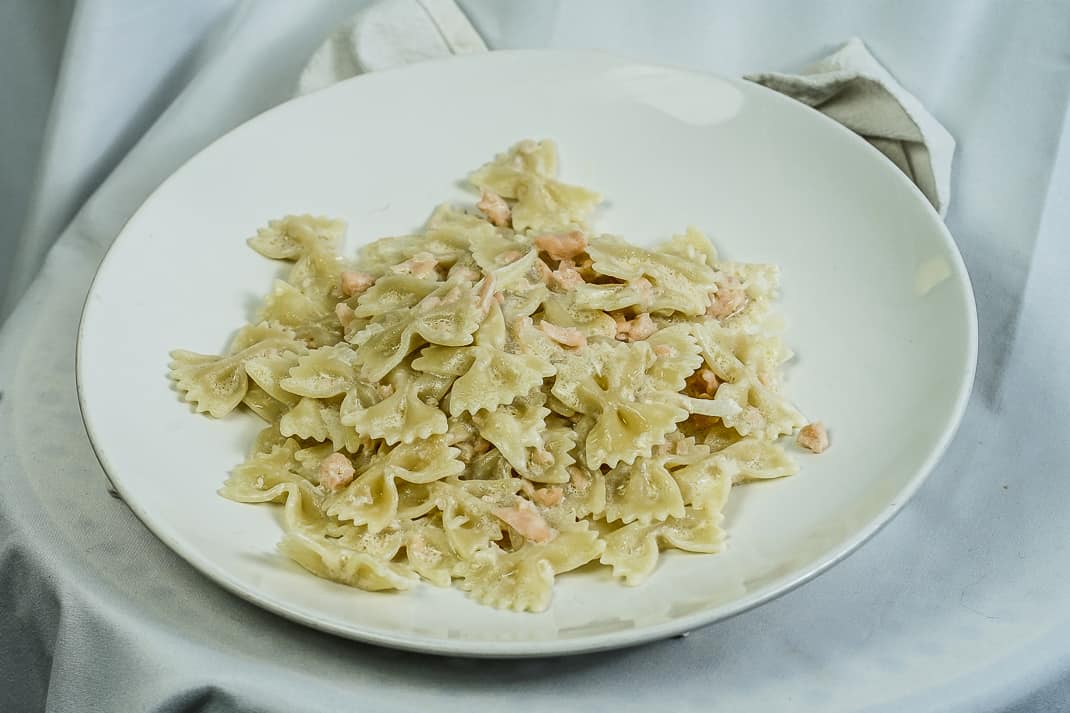
Farfalle alle salmone
This dish is highly popular all over Italy and has no regional origins although the butterfly-shaped farfalle pasta comes from the northern regions of Lombardy and Emilia-Romagna.
Farfalle alle salmone can occasionally be found on menus from Sicily to the Alps but, like lasagna, it’s usually prepared in the home. Salmon is one of those species of fish that costs a month’s rent in Rome restaurants but is cheap in public markets. It is a major bargain considering it’s shipped daily from the Adriatic Sea on the opposite coast.
However, I buy the packaged smoked salmon from Scotland in my supermarket. The smoked flavor adds some major bite to a pasta dish heavy in cream sauce. This is one of Marina’s specialties and I’ve tried to make it one of mine as well.
Ingredients
Farfalle pasta
Half package smoked salmon cut into small pieces
One quarter white onion finely chopped
7 ounces heavy cream
White wine
Salt
Pepper
Extra virgin olive oil
Directions
While cooking the pasta, brown the onions in olive oil for five minutes. Then add the salmon and cook for 5-7 minutes. After the salmon has roasted, splash in a couple fingers of white wine and then add the cream. Cook for two minutes. When pasta is ready, pour into pan and mix thoroughly.
Wine pairing
Soave from Veneto.

Pesto pollo pasta
While some of my favorite Italian dishes date back to the Roman Empire and have roots all over Italy, the origins of pesto pollo pasta are a little closer to home.
Mine.
This is my invention. Pesto pollo pasta is to Italian cooking what Taco Bell is to Mexican. I’m almost ashamed to put the name in italics. But this dish is an ode to my love of pesto, that glorious pistachio-based sauce from Liguria that is good on everything from pasta to bread to crackers to sundried tomatoes.
And chicken, too.
This dish is real fast and real good. It’s hearty. My supermarket sells fresh pasta in its bread and deli area. A big scoop of pasta and a package of chicken and I’m good to go. Just don’t tell your Italian friends unless you want to lose all street cred, even if the street is cobblestone.
Ingredients
Fusilli pasta
Half chicken breast cut into bite-size pieces
3 ounces pesto
10-15 pine nuts
1 sundried tomato, chopped
Garlic clove chopped
Parmesan cheese
Directions
Cook the fusilli, the corkscrew pasta from Puglia that’s perfect for holding the heavy sauce. Brown the garlic in the skillet then brown the chicken, 5-7 minutes. Drain the pasta in a coriander and add the chicken and garlic mix. Pour in the pesto and mix thoroughly. Add the pine nuts and sundried tomato. Add a spoonful of parmesan. Mix again. Put in bowl and add desired amount of parmesan.
Wine pairing
Chardonnay from Veneto.
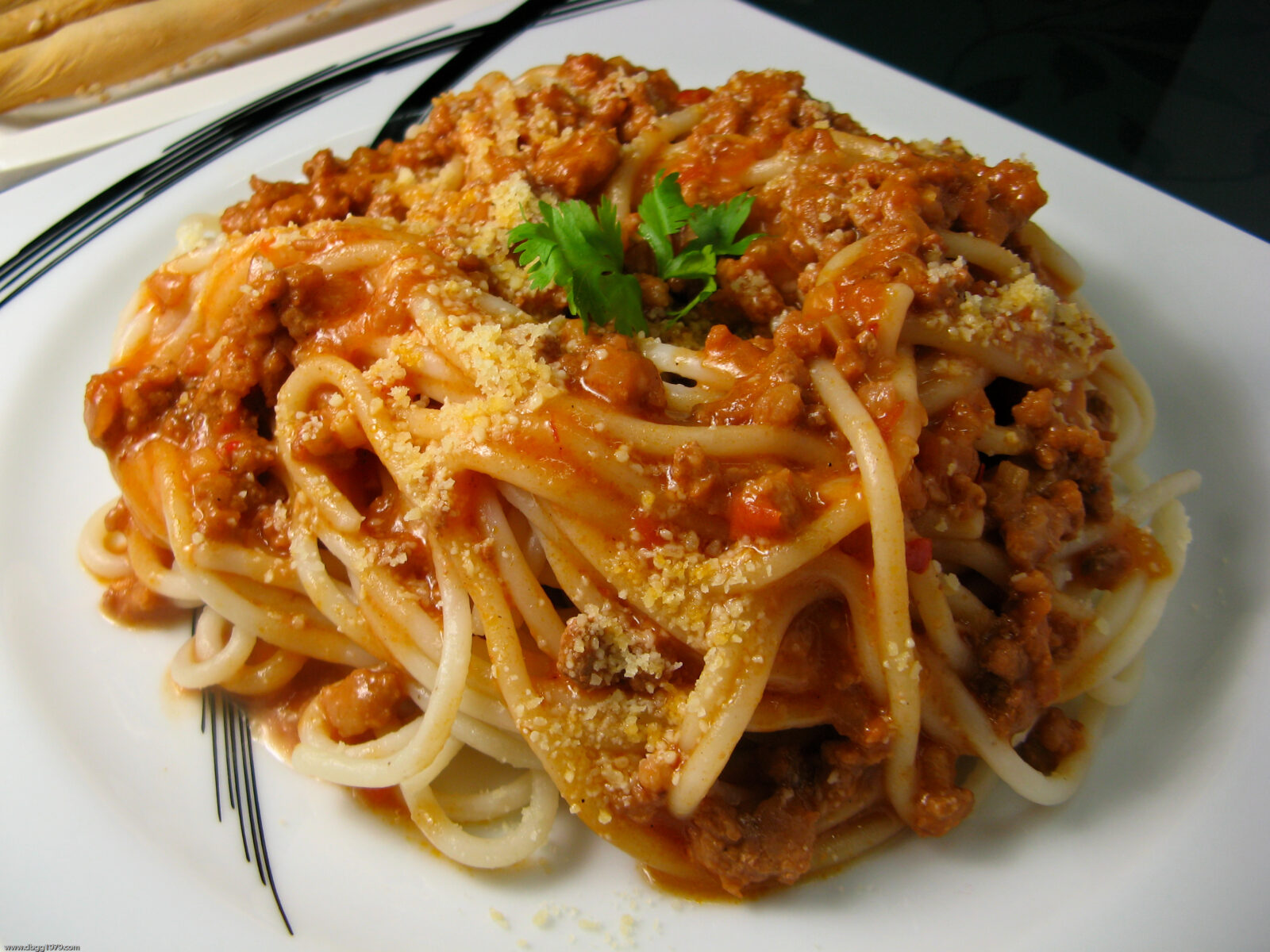
Spaghetti bolognese
This wildly popular worldwide dish is on every Italian restaurant menu from Barstow to Bangkok. It’s a versatile, big-flavor dish that can be used with any kind of pasta, not just standard spaghetti. The ragu sauce is usually served with tagliatelle, the wide flat pasta from Emilia-Romagna and Le Marche in Central Italy. But ragu is so versatile I use it on all kinds of pasta. Famous chef Pellegrini Artusi spent a lot of time in Bologna and included this dish in his 1891 book on Italian cooking, “Science in the Kitchen and the Art of Eating Well.” Thus, the dish became pasta bolognese. Artusi’s recipe used veal and pancetta but many meats can be switched for the traditional ground beef.
Ingredients
Spaghetti
1/4 pound lean ground beef
Can of tomato pulp
Half a carrot, finely chopped
Half a celery stalk, finely chopped
Half glass white wine
Salt
Extra virgin olive oil
Parmesan or pecorino
Directions
Heat olive oil until it sizzles and add carrot and celery over medium heat. When they sizzle, add meat. When brown put in half a glass of the wine and cook 2 minutes. Add salt then a half can of tomato pulp. If too thick — and it often is when I make it — add water. Cook covered for 15 minutes on low heat. While it simmers, cook pasta. Pour pasta into pan and mix thoroughly. Place in bowl and top with parmigiana.
Wine pairing
Barbaresco from Piedmont.
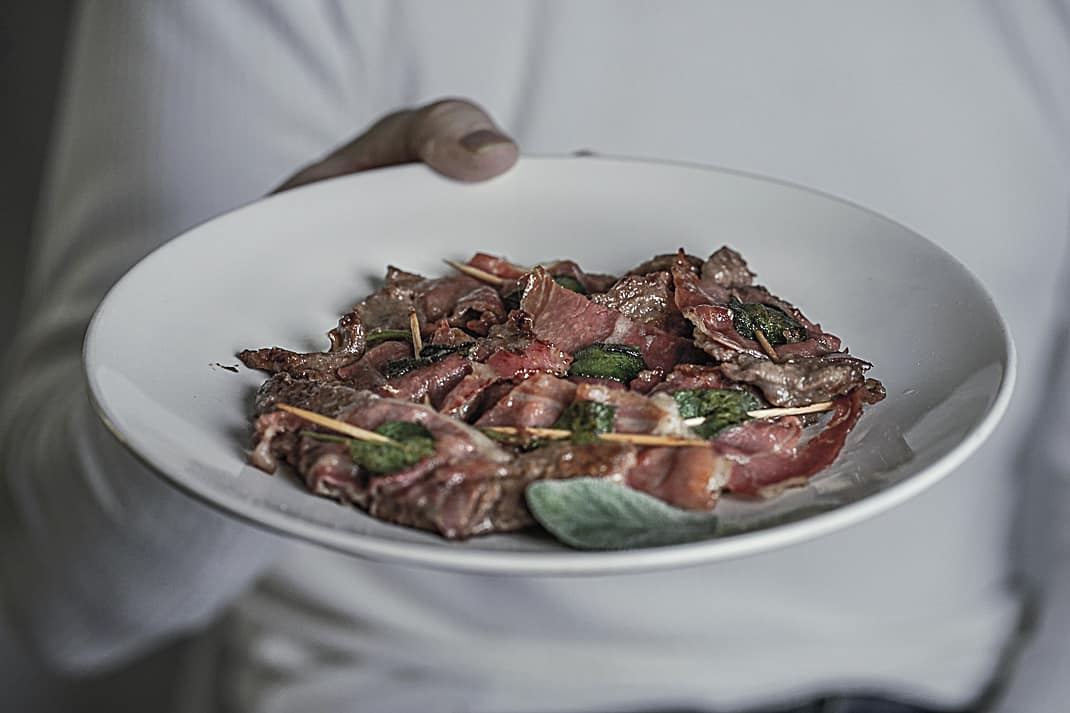
Saltimbocca alla romana
The name comes from “Saltare in bocca” or “jump in mouth” because that’s what the flavor does. It’s a tantalizing combination of lean, thin strips of veal and prosciutto along with my favorite herb: sage. Like many Italian dishes, its origins are a bit mysterious. Some food historians claim it came from the Northern Italian city of Brescia and the Roman culinary culture adopted it in the 1800s. Artusi’s “Science in the Kitchen and the Art of Eating Well,” claims it was first served in Lo Venete, a trattoria in the central Rome neighborhood of Campo Marzo. Regardless, you can now find this dish in restaurants all over the world. It’s also easy to make.
Ingredients
6-7 thin slices of veal
6-7 thin slices of lean prosciutto
Fresh sage
Flour
Salt
Directions
Coat the veal in flour and place a slice of prosciutto on each piece of veal. Top each piece with a small sage leaf. Connect it all with a toothpick and place in pan with olive oil. Cook for 10 minutes over medium-low heat. Sprinkle with a little salt to taste. (A sprinkle with white wine is an option.)
Wine pairing
Pinot Grigio from Alto Adige.
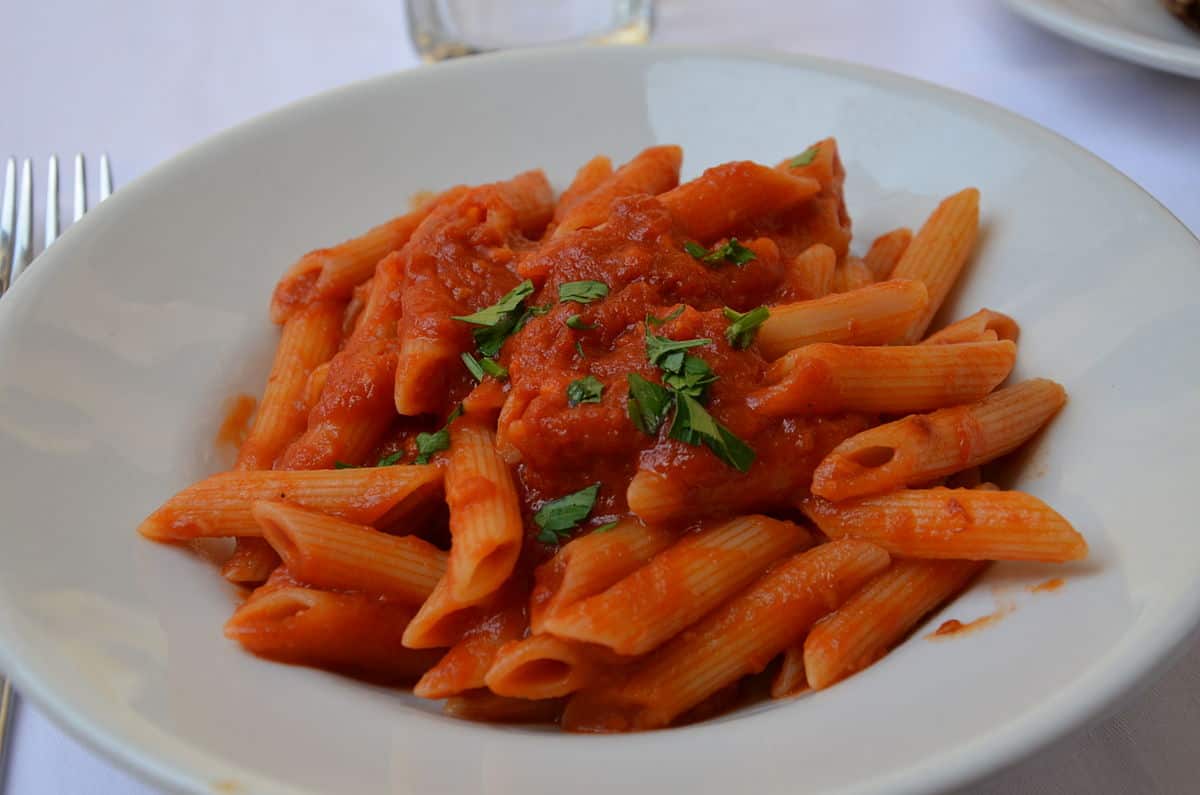
Penne all’arrabbiata
Arrabbiata means “angry” and this dish is the Italian version of an Italian woman scorned. It’s hot. It’s spicy. And you won’t forget it. It’s a classic Roman dish as peperoncini, the Italian red chili peppers, grow abundantly in the Lazio countryside. It’s also so easy to make with the two ingredients all Romans have on hand: chili peppers and tomatoes. It’s earned some fame in Italian cinema, getting mentioned in Federico Fellini’s “Roma” and Marco Ferreri’s “La Grande Abbuffata.” (The Big Feast). Note: Use pecorino and not parmesan to top it. Pecorino sharpens the spiciness of the dish.
Ingredients
Penne pasta
3-4 ripe peeled and crushed tomatoes
Dash of red pepper flakes
1 clove garlic crushed
Parsley
Salt
Extra virgin olive oil
Pecorino
Directions
Saute garlic and pepper flakes over medium-high heat until they soften and turn golden. Add tomatoes and season with salt and cook for 15 minutes. While cooking, cook the short tube-shaped penne pasta. When ready, drain pasta and add to tomato sauce. Toss over medium-high heat. Serve and sprinkle with parsley and pecorino.
Wine pairing
Vermentino from Liguria.
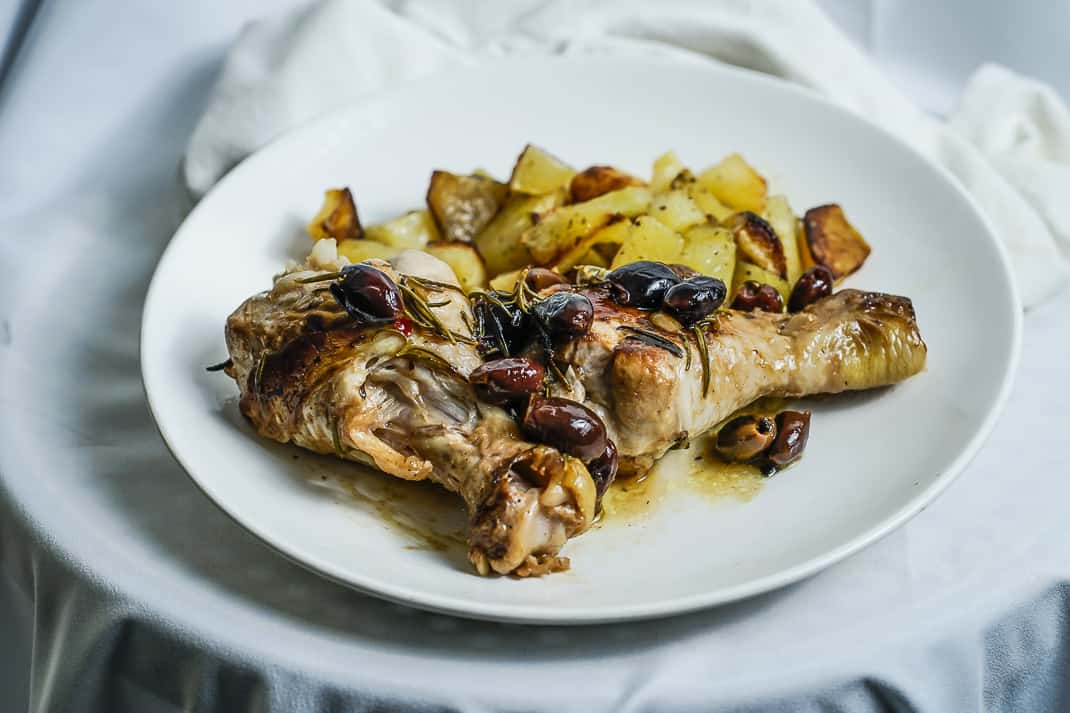
Pollo con patate e olive
Italian meals are served in the form of a primo piatto (first plate) then a secondo piatto (second plate). The primo piatto is usually pasta and the secondo is everything from chicken to meat to sausage. The portions are often big enough to serve as a meal individually and Marina will serve pollo con patate e olive (chicken with potatoes and olives) as a stand alone. It’s very Roman with Roman-style roasted potatoes on the side.
Directions
Two chicken drumsticks or breasts
10 ounces chopped potatoes
1/8 onion chopped
10 pitted black olives halved
1/2 cup white wine
1 teaspoon saffron
1 ounce chicken broth
2 marjoram leaves
Salt
Pepper
Extra virgin olive oil
Directions
Peel and cut the potatoes into small cubes and place them in a bowl of cold water. Set aside. Slice the onion and brown it in a skillet with the oil. Place the chicken in the pan and brown over medium heat and add the white wine. When the wine evaporates, add 2/3 of the broth and saffron. Cook over low heat for 20 minutes. Add salt. After 20 minutes, add the potatoes and olives until the potatoes are cooked and brown on the sides. If too thick, add the remaining broth and salt and pepper to taste. Top with marjoram leaves.
Wine pairing
Grillo from Sicily


February 2, 2021 @ 11:37 pm
I am so happy reading this & now – hungry! I am land locked in the desert in New Mexico but because I left my heart there many years ago, my Facebook profile list my domicile as Rome. Thanks for reminding me why!
February 3, 2021 @ 12:05 am
All excellent choices for your ten go-to Roman dishes, Sir! They were among our favorites when we lived there, as well.
The one local recommendation I would add is carciofi alla giudia: deep fried artichokes, Jewish style. I know there is also a variant called carciofi alla Romana. We tried to make it at home, but it was so much easier (and better) to order it in the Jewish ghetto district, or in a restaurant on the Isola di Tevere. And so much better than American style artichokes, since in Rome you eat the entire thing, including the crispy leaves, heart, and stem. As one would say in Italiano: “yummy.”
April 21, 2021 @ 7:47 pm
Hi John, this week I made puttanesca and tonight having Amatriciana. Puttanesca was yummy and tonight’s pasta dish smells heavenly. Used pancetta. Thanks for that great article.